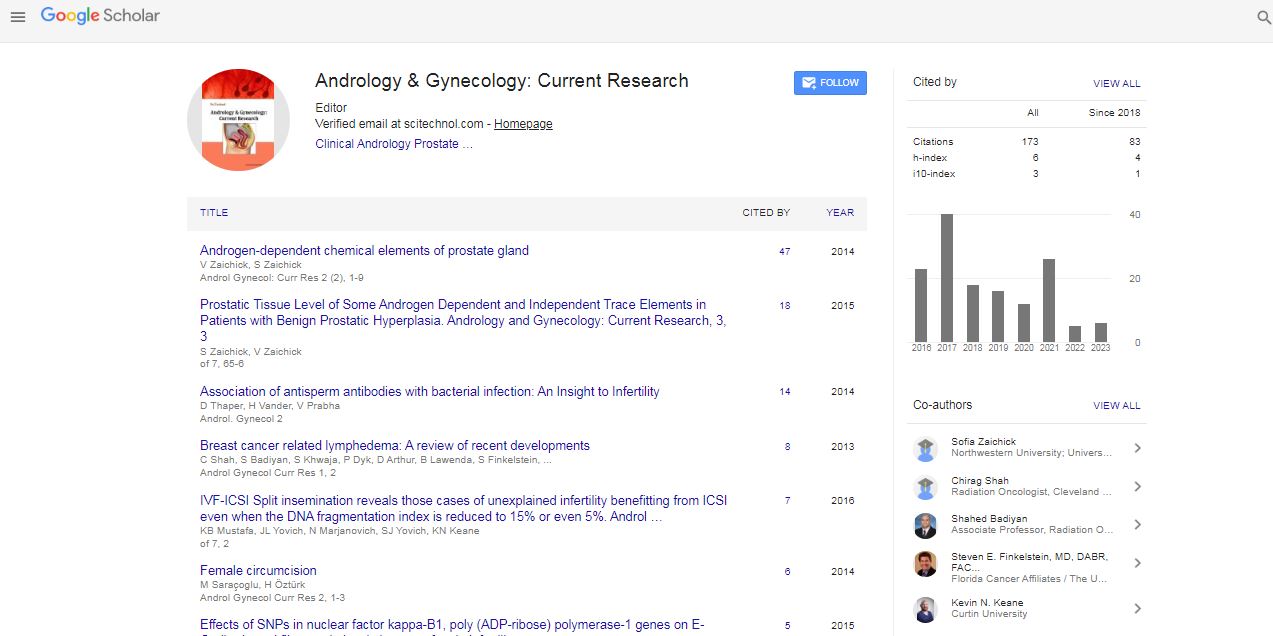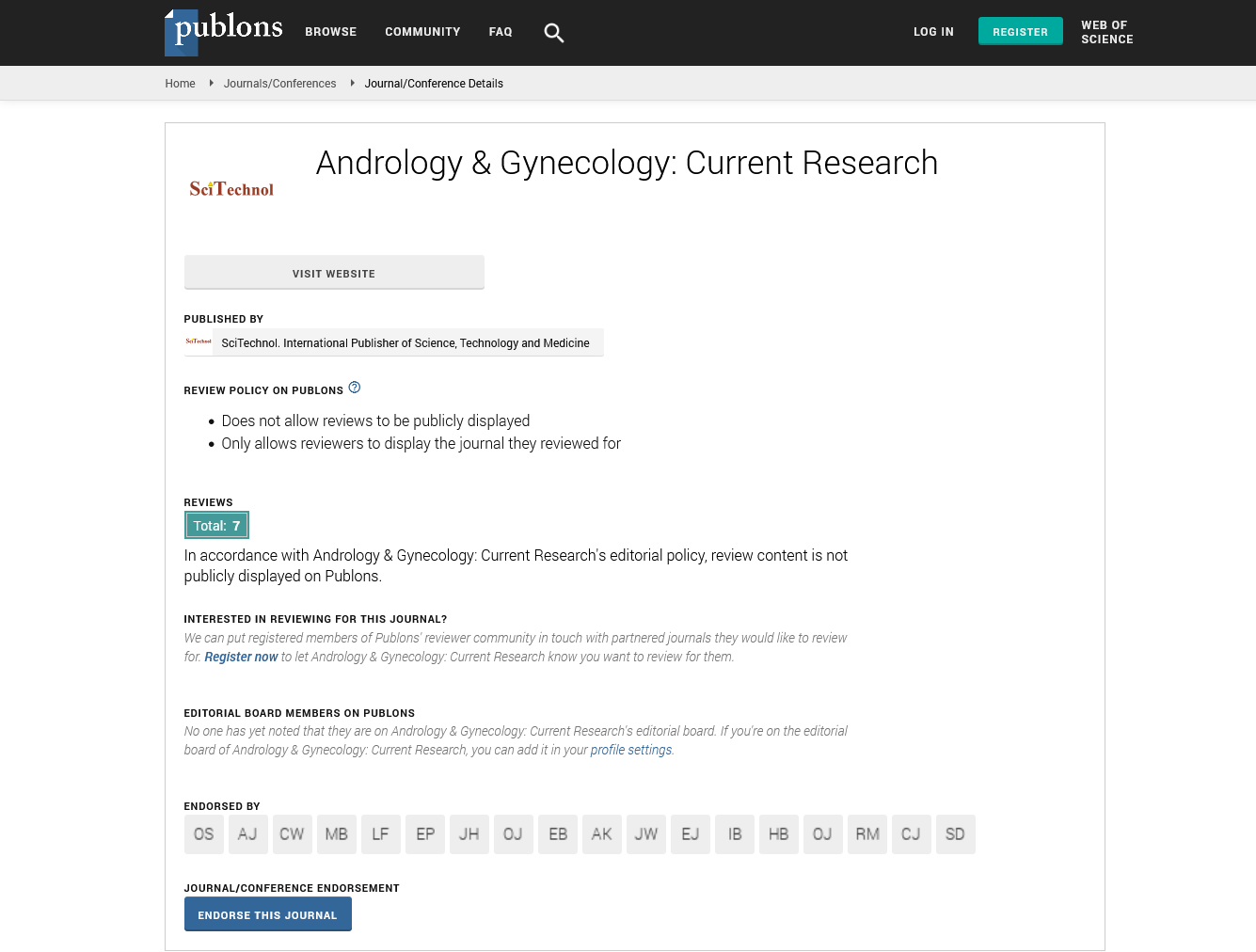Editorial, Androl Gynecol Curr Res Vol: 1 Issue: 3
Recent Advances in Hypogonadism
| Amit Chakrabarty* |
| Urologic Clinics of North Alabama P.C., USA |
| Corresponding author : Amit Chakrabarty Urologic Clinics of North Alabama P.C., 185 Whitesport Drive, Suite 6, Huntsville, AL 35801, USA Tel: 256-650-0306; E-mail: amitcmd@yahoo.com |
| Received: April 12, 2013 Accepted: April 15, 2013 Published: April 17, 2013 |
| Citation: Chakrabarty A (2013) Recent Advances in Hypogonadism. Androl Gynecol: Curr Res 1:3. doi:10.4172/2327-4360.1000e105 |
Abstract
Recent Advances in Hypogonadism
Endometriosis is among Low serum testosterone also known as hypogonadism or Andropause, affects roughly 39% of men over the age of 45. The prevalence of low testosterone increases with age. Researchers have found that the incidence of low testosterone increases from approximately 20% of men over 60, to 30% of men over 70 and 50% of men over 80 years of age.
| Low serum testosterone also known as hypogonadism or Andropause, affects roughly 39% of men over the age of 45. The prevalence of low testosterone increases with age. Researchers have found that the incidence of low testosterone increases from approximately 20% of men over 60, to 30% of men over 70 and 50% of men over 80 years of age. | |
| Besides sexual symptoms such as poor erectile function and low libido low testosterone is associated with non-sexual symptoms including increased body fat, decreased energy and fatigue, reduced muscle mass, and depression. There is an association between hypogonadism and metabolic syndrome [1], which is a constellation of medical disorders including obesity, hypertension, dyslipidemia, hyperglycemia, and insulin resistance, which increase the risk of cardiovascular disease and type 2 diabetes [2]. Hypogonadism is present is 52% of obese men and 50% and 42% of men with diabetes and hypertension, respectively. | |
| Diagnosis of low testosterone is established by evaluation of serum testosterone however there is still lack of accuracy and reliability of present testosterone assays [2]. Recommendations have been made by Endocrine society that is endorsed by the American Urological Association to develop better and more cost effective assays. | |
| Testosterone replacement has been shown to improve a man’s energy, libido (sex drive), muscle mass, sleep, erections, energy level, and depressed mood. Testosterone replacement has been shown to also decrease body fat in men. There is data to support that giving testosterone to a patient with low testosterone may increase their bone mineral density and decrease their risk for a bone fracture [3]. | |
| Testosterone replacement therapy may be in the form of skin gel, injections, long acting pellets, patches or oral inserts. The most common type of therapy is gel therapy, which is used by approximately 70% of patients. Roughly 17% of patients are using testosterone injections and 10% of men are using testosterone patches. Approximately 3% of patients are using other forms of testosterone, such as oral testosterone or implantable testosterone pellets. The use of testosterone pellets offers the only FDA approved testosterone supplementation with long term androgenic effect that offers certain benefits over traditional established treatment options. | |
| Diagnostic tests and follow up schedules with the appropriate tests are important in following these patients on long term testosterone therapy. Contraindications, precautions and side effects of therapy should be understood and discussed with the patient prior to starting the treatment. It is important to realize that testosterone treatment is considered lifelong therapy. | |
| It has been shown that low testosterone increases fat mass and visceral obesity and is associated with insulin resistance. According to a recent population-based study low serum testosterone levels may be associated with an increased risk of death from cardiovascular causes and cancer, independent of age and other risk factors. However, the misconception amongst most physicians and many urologists is that low testosterone is only associated with sexual side effects, underscoring the importance of education of health care providers and developing clinical practice guidelines for evaluation and management of hypogonadism. | |
| The author delivered a lecture on “Updates in Hypogonadism” at the Geriatric Section of the American Urological Association Annual Meeting in Atlanta in 2012 where he presented his personal series on 92 patients treated with 131 insertions of testosterone pellets between April 2009 to March 2012, with a median follow up of 8.5 months. The patients had between 1 (n=32) and 6 (n=3) insertions. 15 insertions used 6 pellets, 21 had 10 pellets inserted and 95 had 12 pellets each. Mean age of the patients was 46.8. Baseline testosterone levels ranged from 29 ng/dL to 473 ng/dL with a mean of 230 ng/ dL. Testosterone levels at three weeks ranged from 300ng/dL to 1500 ng/dL with a mean of 780 ng/dL. At four months the levels varied from 44ng/dL to 1122ng/dL, with a mean of 292 ng/dL. Four (4) adverse events reported (3%, 4/131) that included spontaneous pellet extrusion in two patients, local infection of the insertion tract in one patient 7 days post procedure that was treated successfully with oral antibiotics and mild persistent soreness in the insertion site for about 4 weeks post implantation in one patient which was treated with anti-inflamatories. There were no bleeding complications even in two patients on antiplatelet therapy that was not discontinued. About 15/92 had received previous T-modality and more than 95 % indicated preference for pellets. | |
| 80/80 reported improvement in libido, 47 out of 57 patients reported improvement in energy level, 20 out of 30 patients reported improvement in erectile dysfunction and 1 out of 2 patients reported improvement in anorgasmia. This small retrospective study shows that Testopel pellets can be implanted with low resultant infection and extrusion rate, with resultant high symptom improvement rates and improved serum hormone levels. The therapeutic levels appear to last for less than four months. We concluded that 12 pellets implanted at an interval of 3 to 4 months seem to be ideal. More studies are underway to determine the rationale for the variability of the testosterone levels on follow up and to further refine the dosing schedule. | |
References |
|
|
 Spanish
Spanish  Chinese
Chinese  Russian
Russian  German
German  French
French  Japanese
Japanese  Portuguese
Portuguese  Hindi
Hindi 


